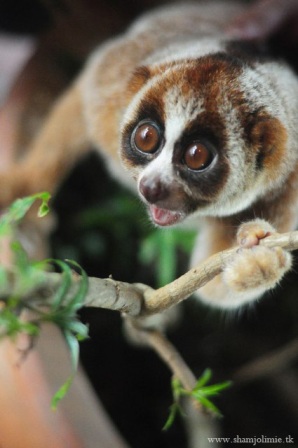
Nutrition
At night, the nocturnal slow loris will slowly
climb around in the trees searching for food. Because of a slow lorises location (habitat), it has access
to many fruits, plant matter, and insects including ants and
termites. Slow lorises also eat plants that produce nectar, the gum (high glucose sap
from trees) and even bird eggs. Their diet makes them primary
and secondary consumers.
Majority of a slow lorises feeding is on sap (about 35%), while plants with nectar (31.7%), and fruits (22.5%) came in a close second.

Although
the average weight for Nycticebus coucang is only 3
pounds, this species is known as a heavier loris because they have
extremely low metabolic rates and eat large amounts at one time.
Their average basal metabolic rate (BMR) (energy burned per day at
complete rest) is 1.5040 W (the rate depends on an animal’s body
mass and body temperature). Most experts estimate their BMR to be
about 60% higher than it truly is.

Nycticebus coucang has the slowest
metabolism of all the other Nycticebus species. Studies
have been done to determine the reason for their slow metabolism,
but it has been found that it is not caused by a low energy diet. In
fact, the slow loris ingests high-energy food.
Birds, which have
very quick metabolisms tend to eat the same type of diet. It is
estimated that the true cause for their slow metabolism is from
toxic insects that inhibit a lorises digestive system. The plant
matter they consume can also have these effects as well.
Go to Reproduction to see how the slow loris reproduces!
Check out MultipleOrganisms.net to see more interesting organisms!
Back to Homepage
